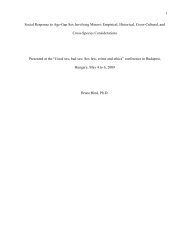Infant and Child Sexuality: A Sociological Perspective - Ipce
Infant and Child Sexuality: A Sociological Perspective - Ipce
Infant and Child Sexuality: A Sociological Perspective - Ipce
Create successful ePaper yourself
Turn your PDF publications into a flip-book with our unique Google optimized e-Paper software.
anticipation, <strong>and</strong> satisfaction.<br />
What would the reactions of preadolescents to their sexual encounters<br />
be if society recognized preadolescent sexual potential, provided<br />
responsible information about sex, <strong>and</strong> allowed for developing sexual<br />
maturity <strong>and</strong> expression? Would the reactions of preadolescents be more<br />
or less negative than they are now? Opinions of both students of human<br />
sexuality <strong>and</strong> parents of preadolescents are divided on this issue <strong>and</strong><br />
empirical evidence is inadequate to predict what the major ramifications<br />
of a program of greater sex education <strong>and</strong> increased sexual permissiveness<br />
would be. One thing is certain, the majority of parents in<br />
the United States appear to be ready to accept more <strong>and</strong> better sex education<br />
for their offspring. It seems reasonable to assume that positive<br />
<strong>and</strong> constructive sexual upbringing would result in more<br />
discriminating interpersonal relations during the preadolescent years<br />
<strong>and</strong> hence in an increase in positive attitudes toward interpersonal intimacy.<br />
Summary<br />
Sexual awakening comes to many during preadolescence. The presence<br />
of sexual-erotic encounters in preadolescence casts doubt on the universal<br />
application of the concept of sexual latency. Other sociological<br />
<strong>and</strong> anthropological research also calls the latency concept into<br />
question as well.<br />
Preadolescence is a period of transition as the changes that begin<br />
during these ages are essential to full adult sexual functioning. The<br />
biological-sexual changes--appearance of pubic hair, development of<br />
breasts, etc.--can be awesome to the preadolescent who is not sure what<br />
his reactions to such phenomenon should be.<br />
Preadolescent boys experience erections in response to varied stimuli.<br />
And masturbation is a common experience for both preadolescent<br />
boys <strong>and</strong> girls. The masturbation fantasy accompanying these experiences<br />
is in large part dependent upon the nature of one’s prior sexual<br />
experiences. Guilt feelings often accompany masturbation as the preadolescent<br />
intuits guilt from the kind of sexual socialization received in<br />
infancy <strong>and</strong> childhood.<br />
Mixed parties are a part of the preadolescent scene <strong>and</strong> while providing<br />
a chance for boy-girl encounters, often precede or signal the<br />
beginning of paired dating. First paired dating frequently occurs <strong>and</strong><br />
even going-steady relationships develop at this early age.<br />
The sexual-erotic encounters of preadolescents are often those carried<br />
over from childhood with elaborations. Exposure, touching <strong>and</strong> fondling,<br />
kissing, dancing, making out at parties, mutual masturbation,<br />
coitus, <strong>and</strong> oral sex occur.<br />
Homosexual activity is also present during preadolescence. About<br />
six percent at the age of five <strong>and</strong> thirty-three percent at adolescence<br />
have had at least one homosexual encounter. While it is generally proscribed<br />
in the United States, many societies encourage homosexual behavior.<br />
130
















